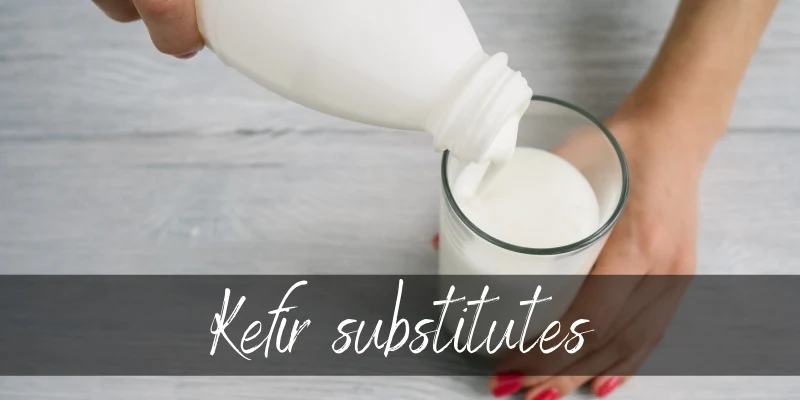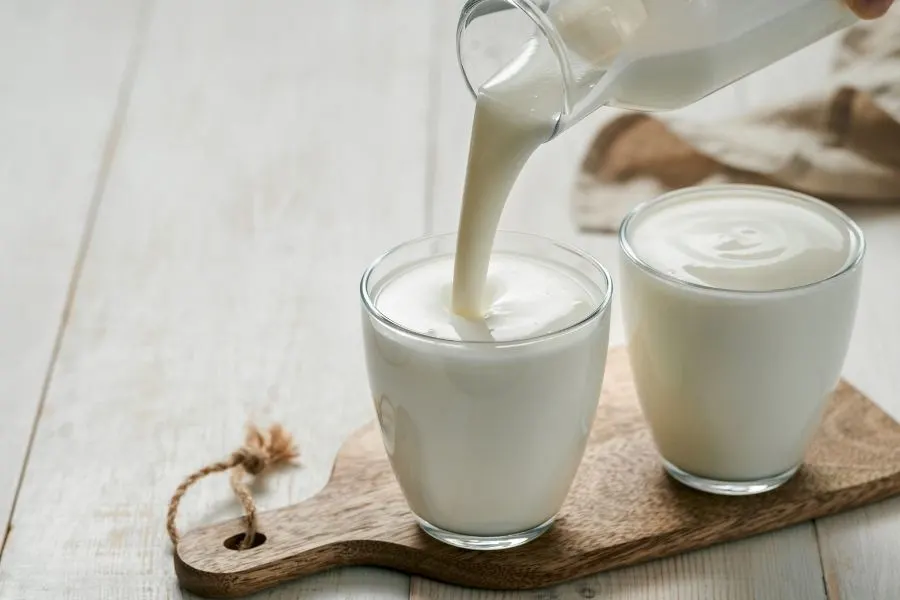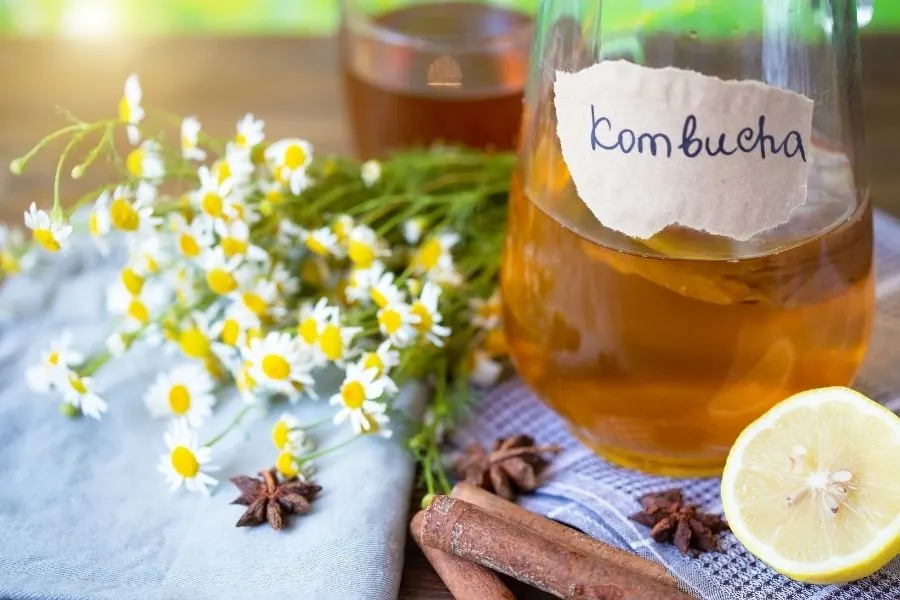Looking to make an amazing cake and it calls for kefir, but you’ve just run out ? Or is it an ingredient you just can’t seem to find in stores, and are looking for a substitute ?
Whatever the case, kefir can be easily substituted for other food items. If you don’t have any on-hand, check out our list for the best replacement and pick whichever works for you.

What is a good kefir substitute?
The best kefir substitutes are cultured buttermilk, a mix of 75% yoghurt and 25% milk, sour cream, kombucha, or pickles. It all depends on what you need the kefir for.
Its main point is fermentation. When used in baking, we recommend the dairy substitutes above. If using for probiotics, we recommend kombucha or pickles.
First let’s see each substitute, then we’ll talk about what kefir is, and answer some FAQs. Kefir is a pretty mysterious milk preparation, so there’s a lot of questions surrounding it.
Cultured buttermilk
If all you’ve got is buttermilk, then by all means use that. it’s just as good as kefir, since this is a fermented dairy drink too. Just as thick (or thin) as kefir, it will work great as a substitute. Feel free to replace it on a 1 to 1 ratio.

Yogurt and milk
If you are cooking and do not have kefir in your fridge or access to it, you can still complete the recipe. Substitute in 3/4 cup yogurt (plain variety) mixed with 1/4 cup of milk as a solid kefir substitute.
This will retain the yogurt’s bacteria and fermentation, but thin it out a little. Or, if you have drinkable yogurt available (plain, unsweetened and with nothing added) then just use that.
Read Also:Sunflower Seed Substitute
Sour cream
Ah yes, another fermented dairy. The only thing is this one has a much higher fat percentage, and a lower fermentation. Use it in your baking and cooking, but know that it’s less acidic than kefir.
Kombucha
Kombucha has a bacterial culture and acid in it too. It might be a little weird to add kombucha to baking, but who are we to stop you? It’s generally much thinner than kefir so it’s best to use less.
If you need it for the probiotics then go ahead. It’ll work just as fine.

Pickles, or pickled anything
The same goes for pickles, or pickled anything. Not the vinegar ones, the brined ones. These are the ones with a bacteria culture and the ones that will help. It could be pickles, pickled cabbage, pickled watermelon (yes, it’s a thing), or whatever you like.
As long as they’re brined, they’re good. If they smell, it’s okay, all bacteria-infused foods smell. Now let’s take a look at what kefir is.
What is kefir?
Kefir is a fermented beverage made out of milk. Any variety of milk can be used, from regular cow milk to soy, goat, sheep, coconut and more. It’s very common in the North Caucasus mountains, Eastern Europe, and Russia. It’s made by letting milk ferment, and adding kefire grains to it to further help the fermentation process.
Like kombucha, kefir has a base bacteria culture. As kombucha has a mother SCOBY, kefir has kefir grains leftover from previous batches.
What does kefir taste like?
It tastes sort of like a tangy yogurt drink, somewhere between solid yogurt and milk. You can buy plain kefir or purchase one of many fruit flavored kefir drinks, such as peach, strawberry, blueberry, mango and more.
Alright, now let’s check out some kefir FAQs, to make sure we know everything about this great milk drink.
Kefir FAQ
Where do I buy kefir?
Most grocery stores carry kefir in stock. You can go to the dairy aisle and usually by the milk or yogurt you can find it. If not, look to the natural foods section to see if they have any to offer. It will be in the refrigerated section.
When should I drink kefir?
You can enjoy a glass of kefir any time of the day or night! It’s delicious and convenient to drink any hour of the day. Some recommend that you should enjoy a serving before you go to bed. Drinking kefir an hour or two before going to sleep could benefit your intestinal flora and contribute to a good night’s rest.
Will kefir help me go to the bathroom?
Probiotics and kefir could help you go to the bathroom, yes. It’s not wise to play around with these, since messing with the internal flora of your guts can cause a disruption in normal bowel movements.
Try kefir, yes, but be careful and don’t overdo it. The healthiest option is to keep kefir to around one cup worth a day
Could I use kefir in place of sour cream in recipes?
Yes, you can if that is what you prefer. Sour cream is often used as part of many baking recipes. You can swap in an equal amount of plain kefir without sweetening to adequately replace it as an ingredient.
Are yogurt and kefir the same thing?
While they share many properties and even taste in common, yogurt and kefir are similar but not the same thing. Yogurt is usually more reliable and has a creamy and thicker feel, often requiring a spoon to be eaten. Kefir is more of a liquid drink that tastes like yogurt but has a different composition and usually a more noticeable tangy flavor from the fermentation. However, both are cultured and made from dairy sources.
What else can I use kefir for instead of other ingredients while cooking or baking?
Kefir can be a suitable replacement in many recipes that call for cream cheese, sour cream, Greek yogurt, regular yogurt, or even goat cheese. Make sure that it matches up to the amount that you need and substitute away! Heat will kill off some of its probiotic properties but it will continue to be nutritious.
How do your store kefir?
Just keep it in your refrigerator and drink soon after opening.
Is kefir better than kombucha?
They’re both good drinks in their own way that bring different things to the table. While both go through fermentation, kombucha is typically brewed using tea. It is a non-dairy drink that is often fizzy and fruit-flavored. It contains acetic acid in addition to lactic acid bacteria, which kefir also retains. It all depends on what you are looking for in a beverage at the moment.
How will my body react to kefir?
Your body may not have much of a reaction. The first initial times drinking kefir, you may find that you may experience light nausea, cramping, or even constipation. This is just the new bacteria affecting your gut.
Are kefir and ayran the same?
They are similar but not exactly the same. Kefir is made from kefir grains, while ayran comes from Greek yogurt diluted with water and with a little salt added before blending. It is served cold or over ice.

What is coconut kefir?
This is a type of kefir made from coconut water combined with kefir grains to ferment. It’s similar to dairy-based kefir and provides support for gut bacteria as well.
Do you have to eat before having kefir?
You can have kefir pretty much any time you want to. You don’t have to eat first. It can be the first thing in your stomach in the morning or the last thing that you have at night. If you’re hungry or just wanting to have a glass of kefir, there’s nothing wrong with having it while hungry or with snacks or after a meal.
Is kefir from milk acidic or alkaline?
It’s overall acidic rather than alkaline. You can even usually taste the acidity in it. That is what is giving your taste buds that tangy flavor.
Is it better to have milk kefir or water kefir?
It all depends on your personal preference. Some people prefer the flavor and consistency of water kefir, while others love the rich flavor that the milk kefir offers.
How can you use kefir?
You can use kefir in a lot of ways. You can put it into a smoothie or use as part of a salad dressing. Use it instead of milk for cereal. You can make a parfait and have it be one or several of the layers. You can bake or cook with it. You could even try making your own probiotic packed desserts using kefir!
Read Also:Raisin Substitutes
What can you add to kefir?
You can add honey to sweeten it or even maple syrup or agave. You could add fruit of any type, choosing to blend it together if you would like to. You can even get creative and add spices, such as nutmeg or cinnamon, cacao nibs, matcha powder, or even bee pollen. The possibilities are endless!
And that’s about it ! Now you know what kefir is, some great substitutes, and some base knowledge.

